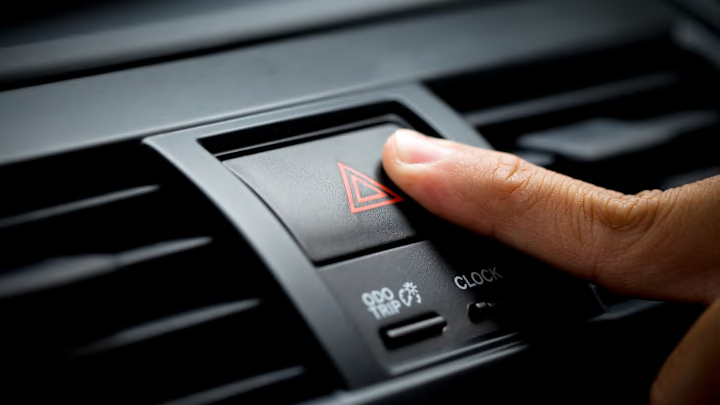Some drivers can spend years on the road and never have to engage their vehicle’s hazard lights—a blinking signal activated by the big red triangle on the dashboard that alerts other motorists of potential danger.
Because hazard lights are not as commonly used as windshield wipers or popping the trunk, some drivers can be confused about when it’s appropriate to light them up. The answer to that can actually vary from state to state, and drivers can also have strong opinions about putting them into practice. Consider this a general guide, but if you’re uncertain, make sure to consult your state’s traffic laws.
Use Hazard Lights When Your Car Breaks Down
If you’re out of gas, your brakes stop working, or your car is otherwise malfunctioning, activating your hazards is a must. When you’re on the road, it alerts motorists that you may not be in control of your vehicle. When you’ve pulled over, it’s a signal that drivers should steer clear of your vehicle. This is especially useful when you need to change a tire on the side of the car facing the road, though obviously you should still exercise extreme caution when doing so and be on the alert for passing cars.
Use Hazard Lights During a Funeral Procession
A funeral procession is one of the few times you should engage your hazards in an operational and moving vehicle, though some processions only advise that the last car in the line activate the lights. Hazards let other drivers on the road know you’ll be driving below the speed limit and that they shouldn’t try to pass or weave in between cars participating in the drive. Other drivers should always yield to procession vehicles.
Use Hazard Lights When You’re Being Pulled Over by a Police Officer
While not doing it probably won’t get you into trouble, it’s good practice to hit your flashers when a police officer flags you down. You’ll be signaling to the officer that you’re aware you need to pull over, and you’ll be alerting other motorists to your vehicle’s stationary status.
Don’t Use Hazard Lights When Parking Illegally
Double-parking or parking where it’s not permitted is never a good idea, and activating your hazards isn’t going to prevent a ticket or even ensure you won’t get struck by a driver who wasn’t expecting an obstacle. Remember that hazards are meant to indicate an unavoidable problem: Dropping off a friend doesn’t quite meet that definition.
Don’t Use Hazard Lights in Bad Weather
Using hazard lights during inclement weather or weather with poor visibility is a contentious topic, with some drivers believing hazards let other drivers know that you’re having trouble seeing what’s ahead of you. But in engaging your flashers, you’re removing your ability to use turn signals, which can further confuse others on the road.
Generally speaking, using hazards in bad weather isn’t recommended. Engaging them can lead other drivers to believe you’re stalled. Instead, opt for wipers and low-beam headlights, as high beams can sometimes reflect off rain or water and worsen visibility.
Many states have actually made using flashers in bad weather illegal. (Florida, previously a no-flash state, changed course and made it legal to use them in low-visibility conditions on roads with speed limits above 55 mph in 2021.)
Regardless of whether a state frowns on their use in rain or fog, it’s always best to pull over whenever conditions make visibility low or nonexistent and wait for weather to improve. And if you do, don’t forget to activate your hazard lights.
